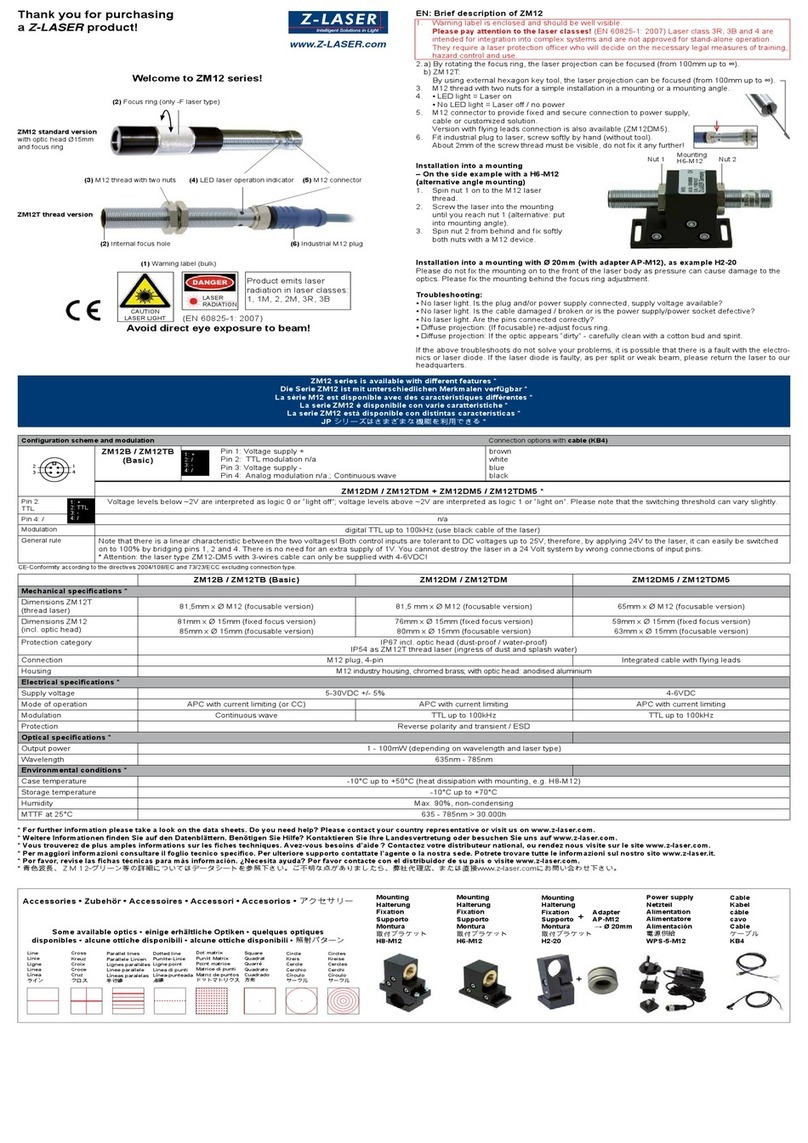
ZX
2018.09.19
4 of 62
Z-Laser Optoelektronik GmbH
Merzhauser Str. 134
D-79100 Freiburg
Tel.: (0761)29644-44
Fax: (0761)29644-55/56
Document-ID: UI-ZL-140011-0.9-2018-09-19
CSCH
Merzhauser Str. 134 ~ 79100 Freiburg ~ Tel.: +49-(0)761-29644-44 ~ Fax: +49-(0)761-29644-55
Dashboard Tab .................................................................................................................... 47
5.6.1 Wavelength Indicator .......................................................................................................... 48
5.6.2 Popt@100% Indicator ......................................................................................................... 48
5.6.3 Item Number Indicator ........................................................................................................ 48
5.6.4 Serial Number Indicator ...................................................................................................... 48
5.6.5 Firmware Vers. Indicator ..................................................................................................... 48
5.6.6 HW Vers. Indicator .............................................................................................................. 48
Lifetime Section ................................................................................................................... 48
5.7.1 Weighted Lifetime Indicator ............................................................................................... 48
5.7.2 Lifetime Laser Diode Indicator ............................................................................................ 49
5.7.3 Diode Temperature Indicator .............................................................................................. 49
5.7.4 Lifetime Related Reliability Indicator .................................................................................. 49
Modulation Section ............................................................................................................. 49
5.8.1 Modulation Indicator .......................................................................................................... 49
5.8.2 Analog Modulation Button .................................................................................................. 49
5.8.3 Digital Modulation ............................................................................................................... 49
Configuration Mode Select Section ..................................................................................... 50
5.9.1 Configuration Modes Select Control ................................................................................... 50
5.9.2 Configuration Mode Description ......................................................................................... 50
5.9.3 Set Selected To Default Button ........................................................................................... 50
Communication Log Window .............................................................................................. 50
Command Wizard Tab ......................................................................................................... 51
5.11.1 Command Select Box........................................................................................................... 51
5.11.2 Search Button ...................................................................................................................... 51
5.11.3 Command Description Box .................................................................................................. 51
5.11.4 Send Data Bytes .................................................................................................................. 52
5.11.5 Byte Descriptions (Send Section) ........................................................................................ 52
5.11.6 Select Buttons (Send Section) ............................................................................................. 52
5.11.7 Multi Slider .......................................................................................................................... 52
5.11.8 Send Button ......................................................................................................................... 52
5.11.9 Clear Cmd Button ................................................................................................................ 53
5.11.10 Error Indicator ..................................................................................................................... 53
5.11.11 Warning Indicator ............................................................................................................... 53
5.11.12 Error/Warning Description .................................................................................................. 53
5.11.13 Receive Data Bytes (Receive Section) ................................................................................. 53
5.11.14 Byte Descriptions (Receive Section) .................................................................................... 53
5.11.15 Select Buttons ..................................................................................................................... 53
ZX-Tracking Tab ................................................................................................................... 54
5.12.1 Start Button (laser diode current section) .......................................................................... 54
5.12.2 Laser Diode Current Diagram .............................................................................................. 54
5.12.3 Sample Time Controls ......................................................................................................... 54
5.12.4 Start Button (temperature section) .................................................................................... 54
5.12.5 Laser Diode Temperature Diagram ..................................................................................... 55
6 Drawings ................................................................................................................... 56
ZX20 (fixed focus) ................................................................................................................ 56




























